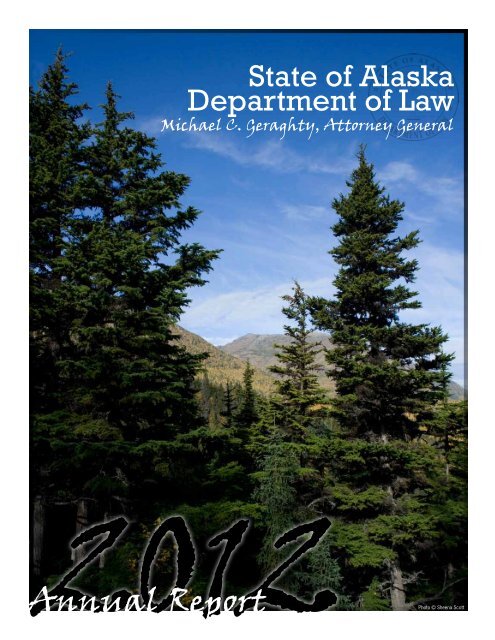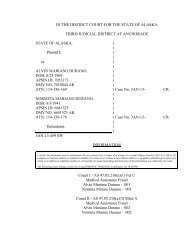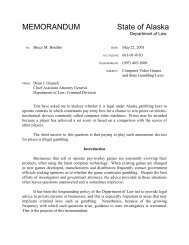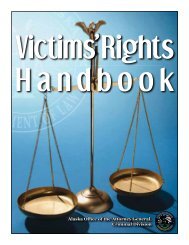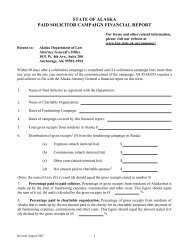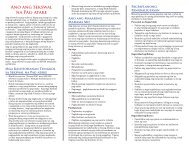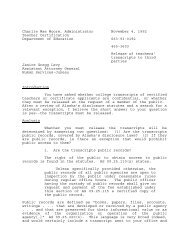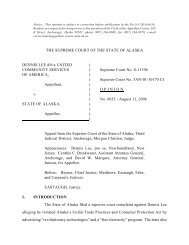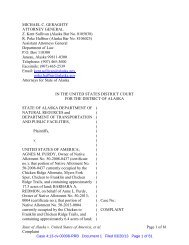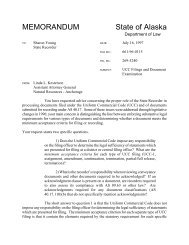Annual Report 2012 - Alaska Department of Law
Annual Report 2012 - Alaska Department of Law
Annual Report 2012 - Alaska Department of Law
Create successful ePaper yourself
Turn your PDF publications into a flip-book with our unique Google optimized e-Paper software.
State <strong>of</strong> <strong>Alaska</strong><br />
<strong>Department</strong> <strong>of</strong> <strong>Law</strong><br />
Michael C. Geraghty, Attorney General<br />
<strong>2012</strong><br />
<strong>Annual</strong> <strong>Report</strong><br />
Photo © Sheena Scott
Table <strong>of</strong> Contents<br />
Message From the Attorney General...........................................................................................1<br />
<strong>Department</strong> <strong>of</strong> <strong>Law</strong> Organizational Chart....................................................................................2<br />
Civil Division..............................................................................................................................3<br />
Standing Up For <strong>Alaska</strong>.....................................................................................................................................4<br />
Child Protection................................................................................................................................................5<br />
Collections and Support....................................................................................................................................6<br />
Commercial and Fair Business...........................................................................................................................7<br />
Environmental...................................................................................................................................................9<br />
Human Services...............................................................................................................................................9<br />
Information and Project Support.......................................................................................................................10<br />
Legislation and Regulations.............................................................................................................................10<br />
Labor and State Affairs...................................................................................................................................11<br />
Natural Resources..........................................................................................................................................13<br />
Oil, Gas and Mining.........................................................................................................................................14<br />
Opinions, Appeals and Ethics...........................................................................................................................15<br />
Regulatory Affairs and Public Advocacy (RAPA)..................................................................................................16<br />
Torts and Worker’s Compensation....................................................................................................................17<br />
Transportation................................................................................................................................................18<br />
Criminal Division......................................................................................................................19<br />
First Judicial District........................................................................................................................................20<br />
Second Judicial District...................................................................................................................................20<br />
Third Judicial District – Anchorage....................................................................................................................21<br />
Third Judicial District – Outside Anchorage........................................................................................................22<br />
Fourth Judicial District.....................................................................................................................................22<br />
Office <strong>of</strong> Special Prosecutions and Appeals ......................................................................................................24<br />
Administrative Services Division...............................................................................................26<br />
Accomplishments/Highlights............................................................................................................................27<br />
Goals and Future Projects................................................................................................................................27
Message From the Attorney General<br />
Dear Governor Parnell and legislators:<br />
The eighteenth century political philosopher Edmund Burke opined that “[n]o other pr<strong>of</strong>ession is more closely connected<br />
with actual life than the law. It concerns the highest <strong>of</strong> all temporal interests <strong>of</strong> man—property, reputation, the peace <strong>of</strong> all<br />
families, the arbitrations and peace <strong>of</strong> nations, liberty, life even, and the very foundations <strong>of</strong> society.”<br />
Times have changed, but Burke’s observation still rings true. The dedicated attorneys and staff at the <strong>Department</strong> <strong>of</strong> <strong>Law</strong><br />
are committed to improving the quality <strong>of</strong> life for our families and communities, and they work hard to make a positive<br />
difference in the lives <strong>of</strong> <strong>Alaska</strong>ns.<br />
Our mission includes four core elements: First, we protect <strong>Alaska</strong>ns. The <strong>Department</strong>’s criminal attorneys prosecute crime<br />
statewide, seeking justice for victims and striving to secure a peaceful and safe state. The <strong>Department</strong> also plays an active<br />
role in the Governor’s comprehensive strategy to end the scourge <strong>of</strong> sexual assault and domestic violence in <strong>Alaska</strong>.<br />
Second, the <strong>Department</strong> <strong>of</strong> <strong>Law</strong> works to promote economic opportunities by using all available legal tools to fulfill the<br />
state’s constitutional obligation to responsibly develop <strong>Alaska</strong>’s natural resources. The <strong>Department</strong> operates on many<br />
fronts in this mission; we provide legal counsel to the state’s resource agencies, affirmatively challenge legal obstacles to<br />
development, and defend against attacks to state development decisions.<br />
Third, we protect the state’s fiscal integrity. We assure that citizens and companies operating in <strong>Alaska</strong> pay all due taxes,<br />
royalties, and other funds. In addition, we defend the state against allegations <strong>of</strong> tort, breach <strong>of</strong> contract and other claims<br />
for damages. Significantly, in November <strong>of</strong> this year we recovered $255 million from BP (<strong>Alaska</strong>) Inc. for lost royalties and<br />
environmental harm caused by pipeline corrosion on the North Slope.<br />
Finally, we are actively engaged in promoting good government. We defend state law and the <strong>Alaska</strong> Constitution. We also<br />
work with the administration to improve all aspects <strong>of</strong> life in <strong>Alaska</strong>, including social services, infrastructure, transportation,<br />
education, consumer protection, fish and wildlife management, child protection, pr<strong>of</strong>essional licensing, environmental<br />
protection, access to and development <strong>of</strong> resources, and much more.<br />
We accomplish all <strong>of</strong> this with a dedicated staff that is committed to <strong>Alaska</strong>. Edmund Burke also observed that “[t]he legal<br />
pr<strong>of</strong>ession renders its practitioners acute, inquisitive, dexterous, prompt in attack, ready in defense [and] full <strong>of</strong> resources.”<br />
That aptly describes the men and women who work in the <strong>Department</strong> <strong>of</strong> <strong>Law</strong>. It is an honor to be able to lead this<br />
outstanding group <strong>of</strong> <strong>Alaska</strong>ns.<br />
Michael C. Geraghty<br />
Attorney General<br />
<strong>Annual</strong> <strong>Report</strong> <strong>2012</strong> ~ <strong>Alaska</strong> <strong>Department</strong> <strong>of</strong> <strong>Law</strong> 1
<strong>Department</strong> <strong>of</strong> <strong>Law</strong> Organizational Chart<br />
Michael Geraghty, Attorney General<br />
Criminal Division<br />
Richard Svobodny,<br />
Deputy Attorney General<br />
John Skidmore,<br />
Division Director<br />
Appeals<br />
Douglas Kossler,<br />
Solicitor General <strong>of</strong> Criminal Affairs<br />
Special Prosecution<br />
Robert Henderson,<br />
Chief Assistant Attorney General<br />
1st Judicial District<br />
David Brower,<br />
Juneau and Sitka District Attorney<br />
Stephen West,<br />
Ketchikan District Attorney<br />
2nd Judicial District<br />
John Earthman,<br />
Nome and Kotzebue District Attorney<br />
J. Michael Gray,<br />
Barrow District Attorney<br />
3rd Judicial District<br />
Sharon Marshall,<br />
Anchorage and Dillingham District Attorney<br />
Scot Leaders,<br />
Kenai District Attorney<br />
Stephen Wallace,<br />
Kodiak District Attorney<br />
Roman Kalytiak,<br />
Palmer District Attorney<br />
4th Judicial District<br />
June Stein,<br />
Bethel District Attorney<br />
J. Michael Gray,<br />
Fairbanks District Attorney<br />
Administrative<br />
Services Division<br />
David Blaisdell, Director<br />
Loretta Withington,<br />
Deputy Director<br />
Management & Financial<br />
Forecasting<br />
Loretta Withington,<br />
Deputy Director<br />
Budgeting<br />
Tracy Maher,<br />
Budget Analyst<br />
Fiscal and Accounting<br />
Deborah Idone,<br />
Finance Officer<br />
Procurement<br />
Patricia Hull,<br />
Procurement Specialist III<br />
Timekeeping & Billing<br />
Loretta Withington,<br />
Deputy Director<br />
Information Services<br />
Jennifer McCaul,<br />
Information<br />
Technology Manager<br />
Civil Division<br />
James Cantor, Deputy Attorney General<br />
Nancy Gordon, Civil Division Chief<br />
Child Protection<br />
Carla Raymond,<br />
Chief Assistant Attorney General<br />
Collections & Support<br />
Stacy Steinberg,<br />
Chief Assistant Attorney General<br />
Commercial & Fair Business<br />
Signe Andersen,<br />
Chief Assistant Attorney General<br />
Environmental<br />
Steve Mulder,<br />
Chief Assistant Attorney General<br />
Human Services<br />
Stacie Kraly,<br />
Chief Assistant Attorney General<br />
Information & Project Support<br />
Alan Birnbaum,<br />
Chief Assistant Attorney General<br />
Labor & State Affairs<br />
Margie Vandor,<br />
Chief Assistant Attorney General<br />
Legislation & Regulations<br />
Deborah Behr,<br />
Chief Assistant Attorney General<br />
Natural Resources<br />
Elizabeth Barry,<br />
Chief Assistant Attorney General<br />
Oil, Gas & Mining<br />
Martin Schultz,<br />
Chief Assistant Attorney General<br />
Opinions, Appeals & Ethics<br />
Joanne Grace,<br />
Chief Assistant Attorney General<br />
Regulatory Affairs & Public Advocacy<br />
Steve DeVries,<br />
Chief Assistant Attorney General<br />
Torts &Workers’ Compensation<br />
Susan Cox,<br />
Chief Assistant Attorney General<br />
Transportation<br />
Jeff Stark,<br />
Chief Assistant Attorney General<br />
2 <strong>Annual</strong> <strong>Report</strong> <strong>2012</strong> ~ <strong>Alaska</strong> <strong>Department</strong> <strong>of</strong> <strong>Law</strong>
Civil Division<br />
The Civil Division provides legal advice to the governor, executive branch agencies, and—<br />
upon request—the legislative and judicial branches. It defends, prosecutes, and oversees all<br />
civil litigation to which the State is a party.<br />
James Cantor is the Deputy Attorney General<br />
overseeing the Civil Division.<br />
<strong>Annual</strong> <strong>Report</strong> <strong>2012</strong> ~ <strong>Alaska</strong> <strong>Department</strong> <strong>of</strong> <strong>Law</strong> 3
Standing Up For <strong>Alaska</strong><br />
In <strong>2012</strong>, the Civil Division participated in a number <strong>of</strong> lawsuits involving federal overreach. The Tenth<br />
Amendment to the U.S. Constitution declares, “The powers not delegated to the United States by<br />
the Constitution, nor prohibited by it to the States, are reserved to the States respectively, or to the<br />
people.” This proclamation defends the scope <strong>of</strong> federalism and embodies state’s rights. Like other<br />
states, <strong>Alaska</strong> <strong>of</strong>ten finds itself on the receiving end <strong>of</strong> federal encroachment and overreach. The<br />
following examples represent the range <strong>of</strong> federalism issues the State faced last year.<br />
Voting Rights Act – The federal Voting Rights Act has<br />
played a significant role in eliminating discriminatory<br />
voting practices, a goal the State <strong>of</strong> <strong>Alaska</strong> strongly<br />
supports. However, one provision <strong>of</strong> the Act imposes<br />
a disproportionate burden on a handful <strong>of</strong> states,<br />
including <strong>Alaska</strong>, by requiring them to gain federal preapproval—known<br />
as “preclearance”—<strong>of</strong> any changes to<br />
their voting laws. The federal government imposed this<br />
extra burden on these states based on voting practices<br />
in the 1960’s, and no attempt has been made to update<br />
the law to reflect current conditions. The preclearance<br />
requirement unnecessarily treats <strong>Alaska</strong> differently from<br />
other states, and causes uncertainty and delays during<br />
elections. For these reasons, the State is challenging<br />
the constitutionality <strong>of</strong> the preclearance requirement<br />
in federal district court and filing an amicus brief in a<br />
related U.S. Supreme Court case.<br />
Emission Control Area – Under a treaty amendment<br />
accepted by Secretary <strong>of</strong> State Hillary Clinton, ships<br />
travelling in a new emission control area (ECA) that<br />
includes <strong>Alaska</strong>n waters must use expensive low-sulfur<br />
fuel. The ECA covers waters within 200 miles <strong>of</strong> the<br />
southcentral and southeastern <strong>Alaska</strong> coasts. The ECA<br />
negatively impacts <strong>Alaska</strong>ns by increasing the cost <strong>of</strong><br />
goods. The State challenged the ECA because there<br />
is no environmental justification for <strong>Alaska</strong>’s coverage,<br />
particularly given that <strong>Alaska</strong> already enjoys air quality<br />
that is generally cleaner than the EPA’s national<br />
standards. The State asserts that under the U.S.<br />
Constitution, the extension <strong>of</strong> the ECA to <strong>Alaska</strong> cannot<br />
be imposed through unilateral action by the Secretary<br />
<strong>of</strong> State, but only by Congress or by the EPA through<br />
formal rulemaking.<br />
Bristol Bay Watershed Assessment – The State<br />
believes that Pebble Mine should be subjected<br />
to the same stringent permitting process as any<br />
other resource development project. Instead, due<br />
to controversy surrounding the project, the federal<br />
government has taken the unprecedented step <strong>of</strong><br />
conducting a watershed assessment <strong>of</strong> Bristol Bay that<br />
could preemptively stop the mine before any specific<br />
mine development and environmental protection<br />
plan has been formally submitted. The <strong>Department</strong><br />
<strong>of</strong> <strong>Law</strong> continues to monitor the process and submit<br />
comments to ensure that the State’s voice is heard.<br />
Although agencies may ultimately determine that the<br />
planned mine cannot coexist with the pristine salmon<br />
habitat in Bristol Bay, the State believes the statutory<br />
and regulatory procedures already in place should be<br />
used to make this determination.<br />
Sackett v. EPA – <strong>Alaska</strong> wrote a U.S. Supreme Court<br />
amicus brief supporting a couple, Mr. and Mrs. Sackett,<br />
stymied by EPA overreach when attempting to build<br />
a house on a small parcel <strong>of</strong> land in Idaho. The EPA<br />
ordered the Sacketts to halt construction and remove<br />
existing improvements, alleging that their lot contained<br />
navigable waters under the Clean Water Act. When the<br />
Sacketts attempted to obtain judicial review <strong>of</strong> this<br />
order, the district court and the Ninth Circuit refused to<br />
hear the case. Both courts held that to obtain judicial<br />
review, the Sacketts would have to violate the order<br />
and then wait for the EPA to bring an enforcement<br />
action against them. The U.S. Supreme Court reversed,<br />
holding that the Sacketts can obtain judicial review <strong>of</strong><br />
their claim that the EPA was wrong.<br />
4 <strong>Annual</strong> <strong>Report</strong> <strong>2012</strong> ~ <strong>Alaska</strong> <strong>Department</strong> <strong>of</strong> <strong>Law</strong>
Child Protection<br />
Protecting <strong>Alaska</strong>’s children is one <strong>of</strong> the most important tasks <strong>of</strong> the<br />
<strong>Department</strong>. The Child Protection Section helps combat child abuse and<br />
neglect in confidential Child in Need <strong>of</strong> Aid (CINA) cases. Child Protection<br />
attorneys help the Office <strong>of</strong> Children’s Services (OCS) (1) implement plans<br />
to safely return children home or (2) take legal action to terminate parental<br />
rights, allowing for placement <strong>of</strong> children in other permanent homes.<br />
Accomplishments/Highlights<br />
• Last year the section worked on<br />
approximately 2,500 ongoing CINA<br />
cases with the goal <strong>of</strong> achieving<br />
permanency for children, whether<br />
through reunification with their<br />
families or other placements, such as<br />
adoption or guardianship.<br />
• The section continued to improve<br />
forms and institute new practices<br />
to comply with the federal Adoption<br />
and Safe Families Act, and to more<br />
efficiently support OCS.<br />
• The section continued to participate<br />
in the Family CARE (Community<br />
Assisted Recovery Efforts) Court.<br />
The project coordinates the efforts <strong>of</strong><br />
the <strong>Department</strong> <strong>of</strong> <strong>Law</strong>, <strong>Department</strong><br />
<strong>of</strong> Administration’s Offices <strong>of</strong> Public<br />
Advocacy and Public Defender, and<br />
the Court System. The program<br />
directly engages and assists parents<br />
<strong>of</strong> children who have been the<br />
subject <strong>of</strong> CINA petitions.<br />
• The section continued to participate<br />
in Family Preservation Court (FPC).<br />
FPC is a therapeutic court for CINA<br />
cases in which substance abuse is<br />
the primary issue. With a goal <strong>of</strong><br />
treatment completion and dismissal<br />
within six months, the court provides<br />
immediate, front-loaded services to<br />
families with minimal child protection<br />
history. The FPC “team” consists<br />
<strong>of</strong> one judge, one court-employed<br />
project coordinator, one Assistant<br />
Attorney General, one guardian ad<br />
litem, one Assistant Public Defender,<br />
two conflict attorneys, and several<br />
treatment providers. Expansion <strong>of</strong><br />
the program is under consideration,<br />
which would help more families<br />
resolve their problems quickly without<br />
the need for continued foster care.<br />
<strong>Annual</strong> <strong>Report</strong> <strong>2012</strong> ~ <strong>Alaska</strong> <strong>Department</strong> <strong>of</strong> <strong>Law</strong> 5
Collections and Support<br />
The Collections and Support Section divides its duties between the<br />
Collections Unit and the Child Support Unit.<br />
The efforts <strong>of</strong> the Collections<br />
Unit generate a positive return on<br />
investment. In FY <strong>2012</strong>, the unit<br />
collected more than $11 million, a<br />
roughly 4% increase over FY 2011. Of<br />
the total collected, about $9.2 million<br />
resulted from garnishment <strong>of</strong> debtors’<br />
permanent fund dividends (PFDs).<br />
The unit collected approximately $2.3<br />
million in restitution payments owed to<br />
crime victims, up 29% from FY 2011.<br />
The unit also collected surcharges and<br />
incarceration costs for the <strong>Department</strong><br />
<strong>of</strong> Corrections (approximately $1.4<br />
million); costs <strong>of</strong> appointed counsel for<br />
the Public Defender Agency (almost<br />
$1 million); and more than $6.2 million<br />
in court fines, minor <strong>of</strong>fense fines,<br />
forfeited bonds, and civil attorney’s fee<br />
awards.<br />
The Child Support Unit helps the<br />
<strong>Department</strong> <strong>of</strong> Revenue’s Child Support<br />
Services Division enforce child support<br />
orders. The unit brings legal actions to<br />
collect child support, establish paternity<br />
and require parents to apply for PFDs,<br />
so the PFD can be garnished and<br />
directed towards child support.<br />
6 <strong>Annual</strong> <strong>Report</strong> <strong>2012</strong> ~ <strong>Alaska</strong> <strong>Department</strong> <strong>of</strong> <strong>Law</strong>
Commercial and Fair Business<br />
The Commercial and Fair Business Section, which includes the Consumer<br />
Protection and Antitrust Unit, represents and advises 15 different<br />
divisions, commissions, and public corporations within the <strong>Department</strong>s<br />
<strong>of</strong> Administration, Revenue, Education and Early Development, Natural<br />
Resources, and Commerce, Community, and Economic Development. The<br />
section also represents and advises 20 pr<strong>of</strong>essional licensing boards and<br />
commissions.<br />
The Consumer Protection and Antitrust<br />
Unit investigates and brings enforcement<br />
actions against businesses that<br />
engage in unfair and deceptive trade<br />
practices. In <strong>2012</strong>, the unit received<br />
and processed over 400 consumer<br />
complaints, <strong>of</strong> which the majority related<br />
to telemarketing “do not call” issues,<br />
retail sales, auto sales and repair, debt<br />
collection, credit practices, and tourism.<br />
The unit also participated in many multistate<br />
enforcement actions resulting in<br />
sizeable recoveries against national<br />
companies whose activities harmed<br />
<strong>Alaska</strong>ns. The unit’s efforts resulted in<br />
collection <strong>of</strong> $13 million for consumers<br />
and the State. Below are notable results<br />
achieved by the unit last year.<br />
Hilcorp Energy Settlement<br />
• The State resolved an antitrust<br />
investigation into the sale <strong>of</strong><br />
Marathon Oil Company’s Cook Inlet<br />
natural gas assets to Hilcorp Energy,<br />
LLC.<br />
• The sale gives Hilcorp control<br />
<strong>of</strong> about 70% <strong>of</strong> the natural<br />
gas currently produced in Cook<br />
Inlet. Most <strong>of</strong> the gas is sold to<br />
southcentral utilities for space heat<br />
and electrical generation.<br />
• The State and Hilcorp entered a<br />
consent decree with the court to<br />
protect consumers against potential<br />
monopoly pricing. The decree caps<br />
the price <strong>of</strong> natural gas sold by<br />
Hilcorp for five years and restricts<br />
the sale <strong>of</strong> natural gas for export<br />
from <strong>Alaska</strong> until local needs are met.<br />
• The decree allows Hilcorp to explore<br />
for new gas reserves and better<br />
develop existing reserves to increase<br />
the overall production <strong>of</strong> natural gas<br />
in the Cook Inlet.<br />
National Mortgage Settlement<br />
• The State participated in the national<br />
mortgage settlement, a historic $25<br />
billion settlement with the nation’s five<br />
largest mortgage servicers—Bank <strong>of</strong><br />
America, Chase, Citi, Ally/GMAC, and<br />
Wells Fargo—over abuses in their<br />
mortgage servicing and foreclosure<br />
practices.<br />
• The total value <strong>of</strong> the settlement to<br />
the State and <strong>Alaska</strong>n consumers is<br />
estimated to be $11 million.<br />
• The State will receive a total <strong>of</strong><br />
$4.3 million.<br />
• <strong>Alaska</strong>n homeowners will benefit<br />
over the next three years from (1)<br />
an estimated $1 million in benefits<br />
from loan modifications and other<br />
direct relief; (2) an estimated<br />
$1.7 million in cash payments to<br />
homeowners who lost homes to<br />
foreclosure from 2008 through<br />
2011 and who suffered servicing<br />
abuses; and (3) an estimated<br />
$4 million in refinanced loans to<br />
“underwater” borrowers.<br />
• With the backing <strong>of</strong> a federal court<br />
order and the oversight <strong>of</strong> an<br />
independent monitor, the settlement<br />
is intended to stop future servicing<br />
and foreclosure misconduct.<br />
“<strong>Alaska</strong> is fortunate to<br />
have missed the real<br />
estate crash affecting<br />
many states in the<br />
Lower 48. At the same<br />
time, some <strong>Alaska</strong>n<br />
families, through no<br />
fault <strong>of</strong> their own, are<br />
struggling to stay<br />
in their homes. This<br />
national mortgage<br />
settlement not only<br />
provides financial<br />
relief to <strong>Alaska</strong>n<br />
borrowers, but puts<br />
in place important<br />
new protections for<br />
homeowners in the<br />
form <strong>of</strong> mortgage<br />
servicing standards.”<br />
– Attorney General<br />
Michael Geraghty<br />
<strong>Annual</strong> <strong>Report</strong> <strong>2012</strong> ~ <strong>Alaska</strong> <strong>Department</strong> <strong>of</strong> <strong>Law</strong> 7
NCO Financial<br />
• <strong>Alaska</strong>, with nineteen other states,<br />
reached a settlement with debt<br />
collection company NCO Financial<br />
Systems, Inc. (NCOF). The settlement<br />
resolves allegations that NCOF<br />
engaged in deceptive and unfair<br />
debt collection and credit reporting<br />
practices.<br />
• Under the settlement, NCOF agreed<br />
to comply with state consumer<br />
protection laws, the Fair Debt<br />
Collection Practices Act and the Fair<br />
Credit <strong>Report</strong>ing Act. The settlement<br />
also requires NCOF to provide<br />
consumers with notice <strong>of</strong> their rights<br />
under state and federal law, and<br />
allows the states to monitor NCOF’s<br />
compliance with the agreement.<br />
• NCOF agreed to pay the states<br />
$575,000; <strong>Alaska</strong>’s share was<br />
$26,562. NCOF also agreed to set<br />
aside a total <strong>of</strong> $50,000 for <strong>Alaska</strong>n<br />
consumers who paid debts they did<br />
not owe or overpaid interest.<br />
Average Wholesale Price<br />
(AWP) Litigation<br />
• The AWP litigation, which was<br />
initiated in 2006 against 41<br />
pharmaceutical companies,<br />
alleges that the pharmaceutical<br />
manufacturers reported false<br />
drug prices, known as “average<br />
wholesale prices.” Providers consult<br />
these prices when determining<br />
reimbursement rates from insurers<br />
and Medicaid agencies.<br />
• As a result <strong>of</strong> the inflated AWPs, the<br />
State’s Medicaid agency reimbursed<br />
pharmacies and other providers<br />
more than they actually paid for the<br />
drugs.<br />
• To date, the State has settled with<br />
most <strong>of</strong> the 41 original defendants.<br />
In <strong>2012</strong>, the litigation yielded<br />
settlements over $7 million (GSK -<br />
$4.1 million; Merck - $2.4 million;<br />
Watson - $1 million).<br />
• Trials have been scheduled for the<br />
remaining defendants in late 2013.<br />
8 <strong>Annual</strong> <strong>Report</strong> <strong>2012</strong> ~ <strong>Alaska</strong> <strong>Department</strong> <strong>of</strong> <strong>Law</strong>
Environmental<br />
The Environmental Section plays a significant role in protecting<br />
<strong>Alaska</strong>’s environment. The section primarily provides advice and legal<br />
representation to the <strong>Department</strong> <strong>of</strong> Environmental Conservation relating<br />
to oil spills, contaminated site cleanups, and enforcement <strong>of</strong> air and water<br />
quality laws. One notable success last year was the final resolution <strong>of</strong> an<br />
enforcement action that began in 2006 when oil leaked from pipelines on<br />
the North Slope.<br />
Arbitration <strong>of</strong> 2006 BP Pipeline<br />
Spills and Shutdown Cases<br />
• The State claimed BP Exploration<br />
(<strong>Alaska</strong>) allowed pipelines to<br />
corrode, resulting in spills and partial<br />
shutdowns <strong>of</strong> the Prudhoe Bay oilfield<br />
production.<br />
• After a four-week arbitration, the<br />
State received $255 million for<br />
environmental damages and lost<br />
revenues.<br />
Human Services<br />
The Human Services Section advises and represents all <strong>of</strong> the divisions<br />
in the <strong>Department</strong> <strong>of</strong> Health and Social Services (DHSS). The section<br />
provides legal services and advice on all licensing matters, including<br />
assisted living home, foster home, and childcare licensing. It advises DHSS<br />
about changes in federal law and steps necessary to maintain maximum<br />
federal participation in public benefit programs. The section helps DHSS<br />
with all certificate <strong>of</strong> need matters, public health matters and third party<br />
recovery and estate recovery under the Medicaid program, as well as all<br />
matters related to Medicaid provider audits. It advises and represents<br />
Adult Protective Services on items such as initiating guardianships and<br />
conservatorships, and addressing issues relating to the Pioneer Homes.<br />
Finally, the section acts as legal counsel for the <strong>Alaska</strong> Psychiatric Institute<br />
and initiates petitions for involuntary mental commitment throughout the<br />
State.<br />
Accomplishments/Highlights<br />
• In <strong>2012</strong>, the section was involved in<br />
fifteen superior court cases alleging<br />
both state and federal constitutional<br />
due process claims. Most <strong>of</strong><br />
those cases included requests for<br />
temporary restraining orders or<br />
preliminary injunctions, sometimes<br />
requiring accelerated motion<br />
practice.<br />
• Notably, the courts certified six <strong>of</strong><br />
those cases as class actions. Such<br />
cases can be intense, and once<br />
they are resolved, section attorneys<br />
provide extensive advice to help the<br />
agencies implement decisions and<br />
avoid future litigation.<br />
<strong>Annual</strong> <strong>Report</strong> <strong>2012</strong> ~ <strong>Alaska</strong> <strong>Department</strong> <strong>of</strong> <strong>Law</strong> 9
Information and Project Support<br />
The Information and Project Support Section advises the <strong>Department</strong> and<br />
other agencies on the management, inter- and intra-agency exchange, and<br />
disclosure <strong>of</strong> information and records.<br />
Accomplishments/Highlights<br />
• Last year the section continued to<br />
counsel agencies on responding<br />
to requests under the <strong>Alaska</strong><br />
Public Records Act. The section’s<br />
assistance included ensuring<br />
requests are clear; records are<br />
preserved; deadlines are met;<br />
extensions are appropriate;<br />
chargeable costs are estimated and<br />
paid in advance when appropriate;<br />
searches are reasonable; protected<br />
information is properly handled;<br />
denials comply with the regulations;<br />
and appeals are properly addressed.<br />
• The section also worked with the<br />
<strong>Department</strong> <strong>of</strong> Administration to<br />
draft, publicly notice, and issue<br />
regulations governing Public Records<br />
Act fee waivers and reductions<br />
under AS 40.25.110(d) and AS<br />
40.25.115(b).<br />
Legislation and Regulations<br />
The Legislation and Regulations Section oversees agency regulations<br />
projects; provides final review <strong>of</strong> regulations; and assigns and tracks all<br />
legislative bills. One <strong>of</strong> the section’s functions is to conduct training for<br />
agency regulations personnel on an annual basis. Last year, the section<br />
conducted four regulations classes for state agencies in Anchorage and<br />
Juneau. The section also provided internal training on both regulations and<br />
legislation for department attorneys.<br />
10 <strong>Annual</strong> <strong>Report</strong> <strong>2012</strong> ~ <strong>Alaska</strong> <strong>Department</strong> <strong>of</strong> <strong>Law</strong>
Labor and State Affairs<br />
The Labor and State Affairs Section handles a wide range <strong>of</strong> issues unique<br />
to the operation <strong>of</strong> state government. A few cases exemplifying the<br />
section’s work are highlighted below.<br />
Moon Rocks Case –<br />
Anderson v. State<br />
• In 1969, in celebration <strong>of</strong> the Apollo<br />
XI moon mission, President Nixon<br />
presented small pieces <strong>of</strong> lunar<br />
material to <strong>Alaska</strong>’s Governor.<br />
• The lunar material was put on<br />
permanent display at the <strong>Alaska</strong><br />
Transportation Museum in<br />
Anchorage. The museum burned in a<br />
fire set by an arsonist in 1973, and<br />
the lunar material was thought lost<br />
among the debris.<br />
• Thirty-seven years later the lunar<br />
material reappeared when a plaintiff<br />
sued the State, claiming he had<br />
found the lunar material in the debris<br />
and that it was rightfully his.<br />
• After the court granted a preliminary<br />
injunction in favor <strong>of</strong> the State, the<br />
plaintiff agreed to dismiss the case<br />
and return the lunar material to the<br />
State.<br />
• The lunar material is now proudly<br />
back on display at the <strong>Alaska</strong> State<br />
Museum after a 39 year hiatus.<br />
Parental Notification <strong>Law</strong> –<br />
Planned Parenthood v. State<br />
• In October, the superior court issued<br />
a decision upholding the <strong>Alaska</strong><br />
Parental Notification <strong>Law</strong> that was<br />
passed by voter initiative in 2010.<br />
The court held that with minor<br />
modifications the law satisfies the<br />
<strong>Alaska</strong> Constitution.<br />
• At its core, the law requires that<br />
the parent <strong>of</strong> any minor seeking<br />
an abortion must be notified at<br />
least 48 hours before the abortion<br />
is performed, except in cases <strong>of</strong><br />
medical emergency, abuse, or when<br />
a minor obtains court permission to<br />
have an abortion without parental<br />
notice.<br />
• Planned Parenthood will likely appeal<br />
the decision to the <strong>Alaska</strong> Supreme<br />
Court.<br />
Susitna-Watana<br />
Hydroelectric Project<br />
• The section has helped the <strong>Alaska</strong><br />
Energy Authority (AEA) on all aspects<br />
<strong>of</strong> the Susitna-Watana Hydroelectric<br />
project.<br />
• In December 2011, AEA began<br />
the formal licensing process,<br />
estimated to take six years, by<br />
filing a Pre-Application Document<br />
with the Federal Energy Regulatory<br />
Commission (FERC).<br />
• Throughout <strong>2012</strong>, the AEA<br />
participated in formal and informal<br />
meetings with FERC, other state and<br />
federal agencies, local entities and<br />
others to discuss environmental and<br />
socioeconomic studies that will be<br />
required for the project.<br />
• In December <strong>2012</strong>, AEA filed its<br />
revised study plan with FERC,<br />
remaining on target for filing the<br />
final license application with FERC in<br />
2015.<br />
Alleged Wrongful Termination <strong>of</strong><br />
Director <strong>of</strong> the Governor’s Office<br />
• A decades-old wrongful termination<br />
case involving the Office <strong>of</strong> the<br />
Governor came closer to final<br />
resolution last year.<br />
• In 1994, Margaret Ward was<br />
terminated as director <strong>of</strong> the<br />
<strong>Annual</strong> <strong>Report</strong> <strong>2012</strong> ~ <strong>Alaska</strong> <strong>Department</strong> <strong>of</strong> <strong>Law</strong> 11
Governor’s Anchorage <strong>of</strong>fice for<br />
the misuse <strong>of</strong> state resources.<br />
She filed a complaint with the U.S.<br />
Equal Employment Opportunity<br />
Commission (EEOC) alleging<br />
that she had been terminated in<br />
retaliation for her support <strong>of</strong> a sexual<br />
harassment complaint made by her<br />
assistant Lydia Jones against an<br />
aide to Governor Hickel. The EEOC<br />
determined that her complaint should<br />
be processed under the Government<br />
Employee Rights Act (GERA) and<br />
subsequently lost the file. The case<br />
lay dormant for nearly ten years.<br />
• After the case was resurrected<br />
in 2003, the State asserted<br />
sovereign immunity, but the Ninth<br />
Circuit sitting en banc determined<br />
the case could not be dismissed<br />
on that theory given some <strong>of</strong> Ms.<br />
Ward’s claims. The applicability <strong>of</strong><br />
sovereign immunity to GERA cases<br />
has particular importance for state<br />
government because GERA intrudes<br />
on the Governor’s ability to determine<br />
who should occupy vital advisory<br />
positions in the administration.<br />
• Last year, the State prevailed after<br />
a hearing before an Administrative<br />
<strong>Law</strong> Judge, who determined that Ms.<br />
Ward had failed to establish a causal<br />
connection between a protected<br />
activity and her termination, and that<br />
even if there was such a connection,<br />
the State had established other<br />
legitimate reasons for her discharge.<br />
• Ms. Ward has appealed the decision<br />
to the EEOC.<br />
12 <strong>Annual</strong> <strong>Report</strong> <strong>2012</strong> ~ <strong>Alaska</strong> <strong>Department</strong> <strong>of</strong> <strong>Law</strong>
Natural Resources<br />
Through litigation, administrative proceedings, and advice to executive<br />
branch agencies, the Natural Resources Section helps support the<br />
responsible development <strong>of</strong> the State’s natural resources. The issues faced<br />
by the section last year included the proposed listing <strong>of</strong> the stellar sea lion<br />
under the Endangered Species Act; the calculation <strong>of</strong> the final judgment in<br />
Carlson v. Commercial Fishing Entry Commission; and the assertion by the<br />
State <strong>of</strong> its rights to certain roads and navigable waterways. One notable<br />
success before the <strong>Alaska</strong> Supreme Court, described below, reversed a<br />
lower court decision that would have required the <strong>Department</strong> <strong>of</strong> Natural<br />
Resources (DNR) to readopt all <strong>of</strong> its land use area plans as regulations.<br />
Bristol Bay Area Land Use Plan –<br />
Nondalton Tribal Council v. State<br />
• In 2009, five Bristol Bay area tribes<br />
and two other groups sued DNR<br />
challenging the 2005 Bristol Bay<br />
Area Plan. The superior court held<br />
that the area plan was actually<br />
a “regulation” as defined by the<br />
Administrative Procedure Act (APA).<br />
• DNR has adopted numerous area<br />
plans in <strong>Alaska</strong> through a process<br />
that differs from the regulations<br />
process. Under the superior<br />
court’s holding that area plans are<br />
regulations, DNR would have had<br />
to readopt all area plans using APA<br />
procedures.<br />
• Instead <strong>of</strong> waiting for the superior<br />
court to decide the remaining<br />
issues in the case, the State sought<br />
immediate review <strong>of</strong> this holding in<br />
the <strong>Alaska</strong> Supreme Court.<br />
• Fortunately, the <strong>Alaska</strong> Supreme<br />
Court agreed with the State that area<br />
plans are not regulations.<br />
• On remand, the plaintiffs included<br />
new claims in their complaint. After<br />
the State moved to dismiss these<br />
new claims, the plaintiffs agreed<br />
to voluntarily dismiss the lawsuit in<br />
exchange for DNR’s commitment to<br />
treat their complaint as a petition to<br />
reclassify land.<br />
<strong>Annual</strong> <strong>Report</strong> <strong>2012</strong> ~ <strong>Alaska</strong> <strong>Department</strong> <strong>of</strong> <strong>Law</strong> 13
Oil, Gas and Mining<br />
The Oil, Gas and Mining Section advises and represents the <strong>Department</strong><br />
<strong>of</strong> Natural Resources (DNR) and the <strong>Department</strong> <strong>of</strong> Revenue. The section<br />
works to protect the State’s interest in the development <strong>of</strong> oil and gas<br />
resources, which are vitally important to <strong>Alaska</strong>. Last year, the section’s<br />
efforts to open the Point Thomson Unit oil and gas field paid <strong>of</strong>f when the<br />
State and the operators executed a settlement agreement that requires<br />
development <strong>of</strong> the unit.<br />
Point Thomson Unit<br />
• For more than two decades, the<br />
lessees <strong>of</strong> the Point Thomson Unit,<br />
an oil and gas field east <strong>of</strong> Prudhoe<br />
Bay, declined to produce reservoirs<br />
containing more than seven trillion<br />
cubic feet <strong>of</strong> natural gas and<br />
hundreds <strong>of</strong> millions <strong>of</strong> barrels <strong>of</strong> oil.<br />
• The State moved to terminate the<br />
unit due to the lack <strong>of</strong> production and<br />
litigated the issue up to the <strong>Alaska</strong><br />
Supreme Court.<br />
• While an <strong>Alaska</strong> Supreme Court<br />
decision was pending, the State and<br />
the lessees finalized a settlement<br />
in which the lessees committed to<br />
begin producing 10,000 barrels per<br />
day <strong>of</strong> condensate at the unit by the<br />
2015-16 season. The lessees agreed<br />
to significantly expand production by<br />
the end <strong>of</strong> 2019 or lose acreage.<br />
• Under the settlement agreement,<br />
ExxonMobil, the unit operator,<br />
must put two existing wells into<br />
production by the end <strong>of</strong> the 2015-<br />
16 winter season and drill at least<br />
one additional well by the end <strong>of</strong><br />
the 2016-17 winter season. DNR<br />
has approved operations that allow<br />
ExxonMobil to drill up to 24 wells<br />
from three pads.<br />
• ExxonMobil anticipates that the<br />
initial development <strong>of</strong> the unit will<br />
provide hundreds <strong>of</strong> jobs. It may<br />
also increase production into TAPS<br />
and provide an important impetus<br />
for large-scale commercialization <strong>of</strong><br />
North Slope natural gas.<br />
14 <strong>Annual</strong> <strong>Report</strong> <strong>2012</strong> ~ <strong>Alaska</strong> <strong>Department</strong> <strong>of</strong> <strong>Law</strong>
Opinions, Appeals and Ethics<br />
The attorneys in the Opinions, Appeals and Ethics Section have several<br />
functions: to handle important or complex appeals; assist with the<br />
appellate work <strong>of</strong> other sections; handle Executive Branch Ethics Act<br />
matters; and provide advice and representation in Indian law matters. In<br />
addition, because the section’s attorneys are skilled at legal research and<br />
writing, they are <strong>of</strong>ten asked to take on or assist with other important<br />
litigation. In this role, several <strong>of</strong> the section’s attorneys assisted last year<br />
with an extremely expedited election lawsuit filed in the United States<br />
District Court.<br />
Voting Rights Act –<br />
Samuelsen v. Treadwell<br />
• Four voters sued the State in federal<br />
district court under the federal Voting<br />
Rights Act, seeking to bar state<br />
<strong>of</strong>ficials from preparing for the <strong>2012</strong><br />
elections until the United States<br />
<strong>Department</strong> <strong>of</strong> Justice approved<br />
(or “precleared”) <strong>Alaska</strong>’s interim<br />
redistricting plan. Had the plaintiffs<br />
succeeded in this lawsuit, <strong>Alaska</strong><br />
likely would have had to postpone its<br />
August <strong>2012</strong> primary election, and<br />
possibly the general election as well.<br />
• The case lasted twenty days from<br />
start to finish, but the team <strong>of</strong><br />
attorneys accomplished a lot in that<br />
short time.<br />
• The State filed briefs challenging the<br />
constitutionality <strong>of</strong> the preclearance<br />
requirement, which imposes special<br />
burdens on certain jurisdictions by<br />
mandating that they obtain approval<br />
from federal <strong>of</strong>ficials before they may<br />
change any law or procedure that<br />
might affect voting.<br />
• This requirement, found in Section 5<br />
<strong>of</strong> the Act, was designed to combat<br />
racial discrimination in voting that<br />
was prevalent in some states when<br />
the Act was passed in 1965. But<br />
Congress included <strong>Alaska</strong> under<br />
Section 5 without any evidence <strong>of</strong><br />
voting discrimination in the State.<br />
Continuing Section 5’s extraordinary<br />
burden is not constitutionally<br />
justifiable. The State’s opposition<br />
to the preliminary injunction was<br />
a significant, complex brief that<br />
included the constitutional challenge<br />
and factual examples <strong>of</strong> the<br />
magnitude <strong>of</strong> Section 5’s burden on<br />
<strong>Alaska</strong>.<br />
• The case became moot when the<br />
<strong>Department</strong> <strong>of</strong> Justice precleared<br />
<strong>Alaska</strong>’s interim redistricting plan,<br />
and was dismissed on the very day a<br />
three-judge panel was scheduled to<br />
hear oral argument.<br />
• As described above in the<br />
“Standing Up for <strong>Alaska</strong>” section,<br />
the State subsequently filed a<br />
lawsuit affirmatively challenging the<br />
preclearance requirement and filed<br />
an amicus brief in a similar lawsuit<br />
currently before the U.S. Supreme<br />
Court.<br />
“The Constitution does not authorize the federal government to dictate every<br />
detail <strong>of</strong> our elections.” – Attorney General Michael Geraghty<br />
<strong>Annual</strong> <strong>Report</strong> <strong>2012</strong> ~ <strong>Alaska</strong> <strong>Department</strong> <strong>of</strong> <strong>Law</strong> 15
Regulatory Affairs and Public<br />
Advocacy (RAPA)<br />
RAPA advocates for the general public interest in matters that come before<br />
the Regulatory Commission <strong>of</strong> <strong>Alaska</strong> (RCA), including the interests <strong>of</strong><br />
consumers who would not otherwise have an effective voice regarding<br />
the rates and services provided by regulated utilities or pipeline carriers.<br />
Regulated public utilities are generally monopoly providers <strong>of</strong> essential<br />
public services (i.e., water, electric power, natural gas for space heat, etc.).<br />
Regulated pipelines are generally common carriers transporting oil or gas<br />
products to meet public utility fuel requirements or to bring hydrocarbons to<br />
market. Two cases RAPA addressed last year are highlighted below.<br />
Kenai Nikiski Pipeline (KNPL)<br />
– Rate Case and Refund<br />
• KNPL is a natural gas pipeline on the<br />
Kenai Peninsula used to transport gas<br />
to ENSTAR and to electric utilities.<br />
Utility consumers ultimately pay –<br />
through their monthly utility bills– the<br />
rate charged to move gas over this<br />
pipeline.<br />
• RAPA participated before the RCA<br />
to investigate whether the rates<br />
KNPL charged to transport gas were<br />
reasonable.<br />
• CINGSA, a new gas storage facility,<br />
began operation in <strong>2012</strong> to store<br />
gas for utilities’ winter use when gas<br />
demand is high. Most <strong>of</strong> the gas<br />
going into (and out <strong>of</strong>) CINGSA is<br />
transported over KNPL.<br />
• Because pipeline rates are directly<br />
impacted by the volume <strong>of</strong> gas<br />
transported, when a pipeline<br />
transports more gas, rates should<br />
generally decrease. RAPA and Cook<br />
Inlet utilities argued KNPL’s rates<br />
should be significantly reduced as a<br />
result <strong>of</strong> increased gas transit over<br />
the pipeline due to CINGSA.<br />
• A settlement was reached by which<br />
KNPL reduced its tariff rates from 20<br />
cents to approximately six cents per<br />
1000 feet <strong>of</strong> natural gas. These cost<br />
savings will be passed through to<br />
utility consumers in their utility rates,<br />
and to other industrial consumers<br />
who use KNPL to transport their gas<br />
to market or for internal consumption.<br />
Infrastructure Improvement<br />
Surcharge – Regulatory<br />
Rulemaking<br />
• Utilities came before the RCA<br />
requesting establishment <strong>of</strong><br />
an infrastructure improvement<br />
surcharge.<br />
• Utilities claim a surcharge is<br />
necessary as a quick recovery vehicle<br />
for utility investments made in new<br />
or replacement infrastructure. The<br />
utilities also argue that a surcharge<br />
will allow consumers to ultimately<br />
save money because utilities will be<br />
able to avoid the cost <strong>of</strong> frequent rate<br />
cases.<br />
• RAPA filings made in this rulemaking<br />
docket oppose the proposed<br />
surcharge because: (1) surcharge<br />
use can result in unnecessary<br />
infrastructure investment, resulting<br />
in higher than necessary consumer<br />
rates, (2) surcharge use can reduce<br />
built-in regulatory incentives for<br />
utilities to control costs between rate<br />
cases, and (3) the utilities’ claims<br />
that surcharge use will reduce the<br />
number <strong>of</strong> rate case filings are<br />
unsubstantiated.<br />
• RCA has not yet issued a decision.<br />
16 <strong>Annual</strong> <strong>Report</strong> <strong>2012</strong> ~ <strong>Alaska</strong> <strong>Department</strong> <strong>of</strong> <strong>Law</strong>
Torts and Worker’s Compensation<br />
The Torts and Worker’s Compensation Section defends the State, state<br />
agencies and state employees against tort claims before the courts<br />
and represents the State as an employer before the <strong>Alaska</strong> Worker’s<br />
Compensation Board. The tort claims handled by the section range from<br />
personal injury, to property damage, to civil rights. The section’s cases<br />
can have far-reaching consequences, as illustrated by the <strong>Alaska</strong> Supreme<br />
Court’s decision last year in State, DOC v. Heisey.<br />
Challenges to AS 09.50.253 –<br />
Certification <strong>of</strong> State Employees<br />
• AS 09.50.253 provides for<br />
substitution <strong>of</strong> the State as a party<br />
in place <strong>of</strong> individual state employee<br />
defendants in certain litigation.<br />
• Under this statute, if a state<br />
employee is sued and the Attorney<br />
General certifies that the employee<br />
was acting within the scope <strong>of</strong><br />
employment, the employee is<br />
dismissed from the case and the<br />
State is substituted as the defendant<br />
for all state law claims. The State’s<br />
defenses then apply to those claims.<br />
• In March <strong>2012</strong>, the <strong>Alaska</strong> Supreme<br />
Court issued its long-awaited opinion<br />
on legal challenges to Attorney<br />
General certification decisions in<br />
State, DOC v. Heisey. As anticipated,<br />
the court held that these decisions<br />
are judicially reviewable.<br />
• The court also held that the Attorney<br />
General’s certification is presumed<br />
to be valid, and placed the burden<br />
on the plaintiff to prove that the<br />
employee’s conduct was not in the<br />
scope <strong>of</strong> employment. The State<br />
prevailed on other collateral issues<br />
and the case returned to the trial<br />
court for further litigation.<br />
• The Heisey standard has been<br />
applied in several legal challenges<br />
to Attorney General certification last<br />
year. To date, the State has prevailed<br />
in every case, with the courts<br />
upholding the State’s substitution in<br />
place <strong>of</strong> the state employee involved.<br />
<strong>Annual</strong> <strong>Report</strong> <strong>2012</strong> ~ <strong>Alaska</strong> <strong>Department</strong> <strong>of</strong> <strong>Law</strong> 17
Transportation<br />
The Transportation Section assists the <strong>Department</strong> <strong>of</strong> Transportation<br />
and Public Facilities and other state agencies with transportation and<br />
infrastructure projects and operations. Section attorneys advise the<br />
agencies on everything from construction issues, real property and right-<strong>of</strong>way<br />
acquisition and disputes, funding issues, airport and Marine Highway<br />
System operations, legislation and regulations, environmental permitting<br />
and compliance issues, and even media contracts for television shows<br />
like “Ice Road Truckers.” Most <strong>of</strong> the section’s efforts are spent helping<br />
its client agencies operate effectively within existing legal frameworks.<br />
However, big projects inevitably spawn big disputes, and to protect<br />
the State’s interests, section attorneys regularly engage in both the<br />
administrative dispute resolution process and litigation—such as the fast<br />
ferry case described below.<br />
Fast Ferry Litigation<br />
• Shortly after the fast ferries Chenega<br />
and Fairweather were delivered<br />
to the State, the engines in both<br />
vessels began rapidly degrading.<br />
Despite numerous attempts at repair,<br />
it appears the engine life will be<br />
substantially less than what the State<br />
was originally promised.<br />
• The State sued both the shipyard<br />
that built the vessels and the<br />
engine manufacturer, alleging, in<br />
part, breach <strong>of</strong> contract, breach <strong>of</strong><br />
warranty, misrepresentation, and<br />
unfair trade practices.<br />
• The State is seeking either<br />
replacement engines or recovery <strong>of</strong><br />
the cost <strong>of</strong> replacement, estimated<br />
to be in excess <strong>of</strong> $30 million.<br />
• The case was delayed after the<br />
shipyard filed for bankruptcy<br />
protection last spring, but trial<br />
against the engine manufacturer is<br />
scheduled for April 2013.<br />
18 <strong>Annual</strong> <strong>Report</strong> <strong>2012</strong> ~ <strong>Alaska</strong> <strong>Department</strong> <strong>of</strong> <strong>Law</strong>
Criminal Division<br />
The Criminal Division works to establish safe and healthy communities by prosecuting and<br />
convicting criminal <strong>of</strong>fenders in urban and rural <strong>Alaska</strong> and by upholding those convictions<br />
on appeal. The Division assists victims and witnesses <strong>of</strong> crimes, and supports the efforts<br />
<strong>of</strong> criminal justice agencies to detect and punish crime through investigation, trial, and<br />
conviction. It also provides general legal services to the <strong>Department</strong>s <strong>of</strong> Corrections and<br />
Public Safety relating to their criminal justice functions. The division maintains district<br />
attorney’s <strong>of</strong>fices in 13 communities throughout the State.<br />
Richard Svobodny is the Deputy Attorney<br />
General overseeing the Criminal Division.<br />
<strong>Annual</strong> <strong>Report</strong> <strong>2012</strong> ~ <strong>Alaska</strong> <strong>Department</strong> <strong>of</strong> <strong>Law</strong> 19
First Judicial District<br />
Drug cases are on the rise in the First Judicial District. The three District<br />
Attorney’s <strong>of</strong>fices in Southeast <strong>Alaska</strong>, located in Juneau, Sitka and<br />
Ketchikan, continue to prosecute many methamphetamine cases, while<br />
heroin and cocaine cases are becoming more frequent. In <strong>2012</strong>, the<br />
mixture <strong>of</strong> cases going to trial resembled that <strong>of</strong> past years, with domestic<br />
violence cases still the most common. The overall trend in Southeast<br />
<strong>Alaska</strong>, however, seems to be toward more drug-related cases, including<br />
burglaries and thefts committed to support drug habits.<br />
In addition to drug-related cases, a<br />
notable murder trial took place in <strong>2012</strong>.<br />
The 2010 murder <strong>of</strong> two Hoonah police<br />
<strong>of</strong>ficers by John Marvin went to trial<br />
in October. Marvin was found guilty <strong>of</strong><br />
two counts <strong>of</strong> first-degree murder—<br />
including, for one <strong>of</strong> the two counts,<br />
murder <strong>of</strong> a peace <strong>of</strong>ficer engaged<br />
in the performance <strong>of</strong> <strong>of</strong>ficial duties.<br />
Although both victims were police<br />
<strong>of</strong>ficers, the jury was only able to find<br />
beyond a reasonable doubt that one <strong>of</strong><br />
the two <strong>of</strong>ficers had been uniformed or<br />
otherwise clearly identified as a peace<br />
<strong>of</strong>ficer. The jury inquired <strong>of</strong> the trial<br />
judge whether it was sufficient to “know”<br />
a person was a peace <strong>of</strong>ficer. The judge<br />
ruled that it was not.<br />
Second Judicial District<br />
The District Attorney’s <strong>of</strong>fices in the Second Judicial District, located in<br />
Barrow, Kotzebue and Nome, observed a troubling increase in assaults<br />
with firearms last year. Both Barrow and Kotzebue have had recent firearmrelated<br />
stand<strong>of</strong>fs with police. Barrow saw seven firearm-related assaults<br />
this past year, a marked increase from prior years.<br />
In <strong>2012</strong>, Nome also experienced a<br />
major influx <strong>of</strong> gold miners over the<br />
summer, many <strong>of</strong> whom came ill<br />
equipped to mine and with significant<br />
out-<strong>of</strong>-state criminal records. When<br />
they did not succeed in finding gold, an<br />
increase in assaults, thefts and DUIs<br />
resulted. As winter approached, the<br />
trend subsided, at least temporarily.<br />
A recent case demonstrates that the<br />
national epidemic <strong>of</strong> copper theft has<br />
reached the 71 st parallel. The Barrow<br />
<strong>of</strong>fice is prosecuting two oil company<br />
employees for attempting to steal<br />
$150,000 worth <strong>of</strong> copper scraps from<br />
the Kuparuk oilfield outside <strong>of</strong> Prudhoe<br />
Bay. According to the allegations, the<br />
two men attempted to send 18,700<br />
pounds <strong>of</strong> scrap to a personal residence<br />
in Anchorage. The material made it as<br />
far as the haul road but was flagged<br />
as suspicious by a Lynden Transport<br />
dispatcher. Doyon Security initiated an<br />
investigation and referred the case to<br />
the North Slope Borough Police.<br />
20 <strong>Annual</strong> <strong>Report</strong> <strong>2012</strong> ~ <strong>Alaska</strong> <strong>Department</strong> <strong>of</strong> <strong>Law</strong>
Third Judicial District – Anchorage<br />
The Anchorage District Attorney’s Office is the largest prosecutor’s <strong>of</strong>fice<br />
in the State. The <strong>of</strong>fice tried 132 cases in <strong>2012</strong>, up approximately 50%<br />
from five years ago. The <strong>of</strong>fice experienced an increase in sexual assault<br />
and sexual abuse <strong>of</strong> a minor cases going to trial—likely due to legislative<br />
changes in how these cases are sentenced. In Anchorage, the courts<br />
hold trials for only half-days and only four days a week. Because <strong>of</strong> this<br />
schedule, trials take longer to complete than in other locations in the<br />
State. Sexual abuse <strong>of</strong> a minor and sexual assault trials, consequently,<br />
take three to four weeks on average to complete—an unfortunate amount<br />
<strong>of</strong> time for the victims <strong>of</strong> these <strong>of</strong>fenses. Approximately the same level <strong>of</strong><br />
resources are going into these cases as the average homicide case.<br />
Anchorage has also seen an increase in<br />
the level <strong>of</strong> violent <strong>of</strong>fenses committed<br />
by <strong>of</strong>fenders who are high on synthetic<br />
drugs such as “spice” and “bath salts.”<br />
“Spice” is a street name for synthetic<br />
marijuana. Unfortunately, the law has<br />
been unable to keep up with spice<br />
because <strong>Alaska</strong>’s statutes reference very<br />
specific chemical compounds, and spice<br />
manufacturers are able to chemically<br />
alter their product so that it does<br />
not contain any banned compounds<br />
but still produces a similar high. As a<br />
result, when a substance is seized and<br />
reported to be spice, chemical analysis<br />
<strong>of</strong>ten reveals that it is not a controlled<br />
substance under <strong>Alaska</strong> law. “Bath salts”<br />
is the term for synthetic drugs used<br />
as substitutes for methamphetamine<br />
and cocaine. Specific testing for these<br />
drugs is currently being performed by<br />
the new State Crime Laboratory. The<br />
law enforcement community and the<br />
Anchorage District Attorney’s Office<br />
have responded to these synthetic drugs<br />
by vigorously prosecuting distributors<br />
and aggressively seeking to confiscate<br />
the proceeds <strong>of</strong> drug sales and property<br />
items used in drug crimes.<br />
A recent case highlights the problems<br />
caused by synthetic drugs: Byron<br />
Syvinski, high on bath salts, attacked<br />
and beat a seven-year-old girl who<br />
was riding her bicycle. She suffered<br />
a serious head injury requiring<br />
hospitalization. At trial for first degree<br />
assault and robbery, the defendant<br />
argued that he had been in a druginduced<br />
psychosis and had not known<br />
what he was doing. Medical testimony<br />
revealed that the hospital cannot<br />
currently test for synthetic drugs, and<br />
had diagnosed the defendant as high<br />
on bath salts by process <strong>of</strong> elimination.<br />
The jury convicted on all counts. The<br />
court imposed a composite sentence<br />
<strong>of</strong> more than 20 years—19.5 years for<br />
this crime plus additional time imposed<br />
because the defendant had violated his<br />
probation in an earlier case.<br />
<strong>Annual</strong> <strong>Report</strong> <strong>2012</strong> ~ <strong>Alaska</strong> <strong>Department</strong> <strong>of</strong> <strong>Law</strong> 21
Third Judicial District –<br />
Outside Anchorage<br />
The Palmer, Kenai, Dillingham, and Kodiak District Attorney’s Offices,<br />
located in the Third Judicial District outside <strong>of</strong> Anchorage, conducted<br />
50 felony and 55 misdemeanor jury trials by November 1, <strong>2012</strong>.<br />
These <strong>of</strong>fices observed several trends over the last year. All noticed a<br />
substantial increase in the number <strong>of</strong> heroin prosecutions. In Kenai and<br />
Palmer, the increase in heroin cases has coincided with decreases in<br />
methamphetamine and pill cases. However, Kodiak has seen an increase<br />
in both heroin and methamphetamine cases, as the street value <strong>of</strong> both<br />
drugs has increased significantly on the island. The increase in drug<br />
cases has been accompanied by a rise in domestic violence and property<br />
<strong>of</strong>fenses related to narcotics.<br />
The district also experienced an<br />
increase in the severity <strong>of</strong> violent crime.<br />
The Kodiak <strong>of</strong>fice, in particular, noted<br />
more strangulation injuries, especially<br />
in domestic violence cases. The <strong>of</strong>fices<br />
have also seen more cases in which<br />
violence, including deadly violence, has<br />
been targeted at law enforcement. In<br />
most <strong>of</strong> these cases, the defendants<br />
have been under the influence <strong>of</strong><br />
alcohol, drugs, or a combination <strong>of</strong><br />
substances.<br />
Prosecuting cases involving domestic<br />
violence remains a priority in the district.<br />
Particular cases, such as State v.<br />
Andrew Thomas, are sad but important<br />
reminders as to why this is such an<br />
important mission. Thomas killed his exgirlfriend<br />
in Palmer by stabbing her and<br />
beating her with a sledgehammer. At his<br />
February <strong>2012</strong> trial, the defense argued<br />
heat <strong>of</strong> passion and lack <strong>of</strong> intent, due to<br />
intoxication, in an attempt to get the jury<br />
to convict on a lesser charge. After a<br />
nine-day trial, the jury convicted Thomas<br />
<strong>of</strong> murder in the first degree and murder<br />
in the second degree. He had 14 prior<br />
criminal convictions, including seven<br />
convictions for assault. He is currently<br />
serving a 99-year sentence.<br />
Fourth Judicial District<br />
The Fourth Judicial District covers the largest area <strong>of</strong> any <strong>of</strong> the four<br />
districts. It stretches from Kuskokwim Bay and Norton Sound east to the<br />
Canadian border and from Fairbanks north to the Brooks Range. The two<br />
regional District Attorney’s Offices covering this area are in Bethel and<br />
Fairbanks. Each <strong>of</strong>fice serves many villages, most accessible only by air.<br />
Although driving while under the<br />
influence (DUI) has been a major<br />
problem in this district for decades,<br />
the district is seeing an alarming trend<br />
toward higher and higher levels <strong>of</strong><br />
intoxication. Breath tests showing blood<br />
alcohol content above .20% used to be<br />
the exception, but they are becoming<br />
commonplace. Drivers frequently<br />
are also under the influence <strong>of</strong> other<br />
substances in addition to alcohol. These<br />
cases <strong>of</strong>ten end with tragic results; the<br />
Fairbanks <strong>of</strong>fice prosecuted several<br />
vehicular homicides last year in which<br />
22 <strong>Annual</strong> <strong>Report</strong> <strong>2012</strong> ~ <strong>Alaska</strong> <strong>Department</strong> <strong>of</strong> <strong>Law</strong>
drivers had alcohol levels exceeding<br />
.20% and cocaine or marijuana in their<br />
blood streams.<br />
In the Yukon-Kuskokwim Delta, which<br />
contains Bethel and 56 surrounding<br />
Native villages, crimes related to<br />
substance abuse comprise over 95% <strong>of</strong><br />
prosecutions. However, unlike Fairbanks,<br />
the lack <strong>of</strong> a road system means the<br />
substance abuse is more <strong>of</strong>ten linked<br />
with crimes against people, rather<br />
than DUIs. Alcohol has many negative<br />
effects on the Delta beyond those<br />
reached by the criminal justice system—<br />
ranging from truancy <strong>of</strong> children whose<br />
parents are habitually intoxicated, to<br />
unavailability <strong>of</strong> items in stores such as<br />
hand sanitizer, mouthwash, and white<br />
wine vinegar that are <strong>of</strong>ten stolen and<br />
consumed for their alcohol content.<br />
In addition to alcohol issues, the Delta<br />
has also seen a recent increase in<br />
drug-related prosecutions; marijuana<br />
and heroin have become more popular.<br />
Last year the Bethel <strong>of</strong>fice dealt with<br />
four murder cases, all <strong>of</strong> which involved<br />
substance abuse. In one case, the<br />
defendant was convicted <strong>of</strong> seconddegree<br />
murder for beating his girlfriend<br />
to death. Over the course <strong>of</strong> several<br />
days <strong>of</strong> heavy drinking, the defendant<br />
beat the victim so severely that she died<br />
<strong>of</strong> blood poisoning from a perforated<br />
bowel.<br />
<strong>Annual</strong> <strong>Report</strong> <strong>2012</strong> ~ <strong>Alaska</strong> <strong>Department</strong> <strong>of</strong> <strong>Law</strong> 23
Office <strong>of</strong> Special Prosecutions<br />
and Appeals<br />
Special Prosecutions<br />
The Special Prosecutions Unit handles highly specialized crimes, such<br />
as cyber crimes, alcohol interdiction, environmental crimes, fish and<br />
game <strong>of</strong>fenses, criminal non-payment <strong>of</strong> child support, cold cases, and<br />
various types <strong>of</strong> fraud involving Medicaid, public assistance, Permanent<br />
Fund Dividends, taxes, and workers’ compensation. The unit is also<br />
responsible for reviewing all deaths resulting from police <strong>of</strong>ficer-involved<br />
activities, and takes on cases that pose a conflict for district attorney’s<br />
<strong>of</strong>fices throughout the State. In the past year, the Special Prosecutions<br />
Unit consolidated with the Rural Prosecutions Unit. The unit became<br />
increasingly forward-looking, collaborative and creative in its prosecutions<br />
and added dynamic new prosecutors to the team.<br />
The prosecution <strong>of</strong> Randy Hahn serves<br />
as an example <strong>of</strong> the increased<br />
collaboration and aggressive<br />
prosecution taken on by the unit. In<br />
2004, the State began collecting<br />
vehicle rental taxes. Mr. Hahn owned<br />
and operated Anchorage-based Kiska<br />
Corporation and its subsidiary, High<br />
Country Car and Truck Rentals. In 2004,<br />
the <strong>Department</strong> <strong>of</strong> Revenue notified<br />
High Country that it was required to<br />
file tax returns and to pay the tax due<br />
on revenue generated from vehicle<br />
rentals. Five years later, High Country<br />
still had not paid any taxes. A three-year<br />
investigation revealed that High Country<br />
owed the State almost $400,000 in<br />
unpaid taxes and another $300,000 in<br />
penalties and interest since 2004. In<br />
September <strong>2012</strong>, Hahn was convicted<br />
and sentenced to spend six months in<br />
jail and to pay $71,000 a year for nine<br />
years to the State.<br />
24 <strong>Annual</strong> <strong>Report</strong> <strong>2012</strong> ~ <strong>Alaska</strong> <strong>Department</strong> <strong>of</strong> <strong>Law</strong>
Appeals<br />
The Appellate Unit represents the State in criminal appellate proceedings<br />
and state and federal post-conviction and habeas corpus proceedings; it<br />
also handles civil litigation challenging statutes related to criminal justice.<br />
The unit observed two trends this past year. First, the unit has seen a<br />
marked increase in appeals involving the superior court’s three-judge<br />
sentencing panel—a legislatively created panel <strong>of</strong> judges who can deviate<br />
from a presumptive sentence if imposing the presumptive sentence would<br />
be manifestly unjust. This appears to be in part due to the increased<br />
presumptive sentencing ranges for sexual assault and sexual abuse<br />
crimes, and in part due to more requests by defendants to be referred to<br />
the three-judge panel, regardless <strong>of</strong> the nature <strong>of</strong> their underlying crimes.<br />
The second observed trend is an increase in appeals raising constitutional<br />
issues regarding the Confrontation Clause (i.e., a criminal defendant’s right<br />
to confront and cross-examine witnesses testifying for the prosecution).<br />
This trend is undoubtedly due to a series <strong>of</strong> recent U.S. Supreme Court<br />
cases exploring the parameters <strong>of</strong> the Confrontation Clause.<br />
One <strong>of</strong> the most significant appellate<br />
decisions for the unit last year was<br />
the <strong>Alaska</strong> Supreme Court’s reversal<br />
<strong>of</strong> the Court <strong>of</strong> Appeals in State v.<br />
Gibson. The Court held that the police<br />
may enter a home without a warrant<br />
when they determine that serious<br />
domestic violence has occurred and<br />
it is unclear whether all people who<br />
may have been affected (including<br />
children) are accounted for. The facts<br />
<strong>of</strong> the case exemplify the <strong>of</strong>ten dynamic<br />
circumstances the police confront when<br />
responding to reports <strong>of</strong> domestic<br />
violence. The police were dispatched<br />
to a trailer home on the basis <strong>of</strong> a<br />
woman’s 9 1 1 call reporting that her<br />
boyfriend was threatening to stab<br />
her in the head. During the call, the<br />
dispatcher could hear a disturbance<br />
in the background. When the police<br />
arrived, a woman came running out <strong>of</strong><br />
the trailer; she was hysterical, bleeding<br />
from her head, and wearing only a<br />
tank top. The police took a man into<br />
custody and secured the woman in a<br />
patrol car. When asked, the woman told<br />
the police that no other people were<br />
in the trailer. Given the circumstances,<br />
the police did not believe the woman<br />
and entered the trailer to check for<br />
other victims where they discovered a<br />
methamphetamine laboratory. The Court<br />
<strong>of</strong> Appeals held that the police should<br />
not have entered the home without a<br />
warrant, but Assistant Attorney General<br />
William Hawley—who has served the<br />
State for over four decades—convinced<br />
the <strong>Alaska</strong> Supreme Court to reverse,<br />
holding that the entry was permissible<br />
under the circumstances.<br />
<strong>Annual</strong> <strong>Report</strong> <strong>2012</strong> ~ <strong>Alaska</strong> <strong>Department</strong> <strong>of</strong> <strong>Law</strong> 25
Administrative Services<br />
Division<br />
The Division <strong>of</strong> Administrative Services provides administrative support to the Civil and<br />
Criminal Divisions to free up the efforts <strong>of</strong> both divisions to carry out the mission <strong>of</strong><br />
the <strong>Department</strong>. Its functions include procurement, information technology, budgetary<br />
actions, restitution collections and disbursements, timekeeping, and human resources.<br />
Dave Blaisdell is the Director <strong>of</strong> the<br />
Administrative Services Division.<br />
26 <strong>Annual</strong> <strong>Report</strong> <strong>2012</strong> ~ <strong>Alaska</strong> <strong>Department</strong> <strong>of</strong> <strong>Law</strong>
Accomplishments/Highlights<br />
• The Division helped the <strong>Department</strong> with<br />
awards and collections that exceeded<br />
$300 million.<br />
• The Division administered over 125<br />
pr<strong>of</strong>essional services contracts,<br />
managed a nearly $100 million budget<br />
and oversaw the information technology<br />
for the <strong>Department</strong>. The information<br />
technology continued to grow with:<br />
• the expanded deployment <strong>of</strong> the case<br />
management system,<br />
• the development <strong>of</strong> a receipting<br />
program,<br />
• the deployment <strong>of</strong> an evidence<br />
tracking tool allowing the electronic<br />
transfer <strong>of</strong> evidence to defense<br />
attorneys, and<br />
• the deployment <strong>of</strong> an electronic<br />
discovery application to be used<br />
in both gathering discovery and<br />
responding to public records.<br />
• The Division supplied many prosecutors<br />
with iPads to assist them in providing<br />
more effective representation <strong>of</strong> the<br />
State.<br />
• The Division completed renovation<br />
<strong>of</strong> the Anchorage <strong>of</strong>fice data center,<br />
which ensures the protection <strong>of</strong> all<br />
hardware because there are now proper<br />
environmental controls.<br />
• Efforts are underway to deploy CITRIX,<br />
a remote connectivity service. Initial<br />
deployments to the Civil Division rural<br />
<strong>of</strong>fices have enabled those <strong>of</strong>fices to use<br />
the case management system, instead<br />
<strong>of</strong> sending information to Anchorage<br />
to be entered. The <strong>Department</strong> is now<br />
incorporating CITRIX into the Criminal<br />
Division’s operations. This will enable the<br />
Criminal Division to upgrade their existing<br />
desktop s<strong>of</strong>tware from Office 2003 to<br />
Office 2010, the current State <strong>of</strong> <strong>Alaska</strong><br />
standard.<br />
• The Division added an employee to carry<br />
out the human resource functions that<br />
were formerly centralized within the<br />
Division <strong>of</strong> Personnel.<br />
Goals and Future Projects<br />
• In addition to the new receipting program<br />
described above, the Division hopes to<br />
incorporate data sharing between the<br />
<strong>Department</strong> and the Court System to<br />
further increase efficiencies.<br />
• The <strong>Department</strong> is starting a project to<br />
replace the Criminal Division’s obsolete<br />
case management system with a system<br />
that is up to current business standards.<br />
• The Division’s procurement and<br />
finance <strong>of</strong>fices continue to work with<br />
the <strong>Department</strong> <strong>of</strong> Administration on<br />
statewide system replacements that<br />
will change the business processes<br />
related to procurement and financial<br />
management.<br />
Photo Credits: Page 12, 13, 14 © <strong>Alaska</strong> Division <strong>of</strong> Community & Business Development. Page 18 © DOT<br />
<strong>Annual</strong> <strong>Report</strong> <strong>2012</strong> ~ <strong>Alaska</strong> <strong>Department</strong> <strong>of</strong> <strong>Law</strong> 27
Photo © Sheena Scott<br />
<strong>2012</strong>


